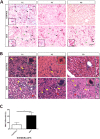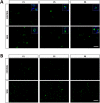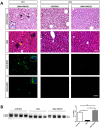Survival Motor Neuron (SMN) protein is required for normal mouse liver development
- PMID: 27698380
- PMCID: PMC5048144
- DOI: 10.1038/srep34635
Survival Motor Neuron (SMN) protein is required for normal mouse liver development
Erratum in
-
Corrigendum: Survival Motor Neuron (SMN) protein is required for normal mouse liver development.Sci Rep. 2016 Nov 10;6:35898. doi: 10.1038/srep35898. Sci Rep. 2016. PMID: 27830828 Free PMC article. No abstract available.
Abstract
Spinal Muscular Atrophy (SMA) is caused by mutation or deletion of the survival motor neuron 1 (SMN1) gene. Decreased levels of, cell-ubiquitous, SMN protein is associated with a range of systemic pathologies reported in severe patients. Despite high levels of SMN protein in normal liver, there is no comprehensive study of liver pathology in SMA. We describe failed liver development in response to reduced SMN levels, in a mouse model of severe SMA. The SMA liver is dark red, small and has: iron deposition; immature sinusoids congested with blood; persistent erythropoietic elements and increased immature red blood cells; increased and persistent megakaryocytes which release high levels of platelets found as clot-like accumulations in the heart. Myelopoiesis in contrast, was unaffected. Further analysis revealed significant molecular changes in SMA liver, consistent with the morphological findings. Antisense treatment from birth with PMO25, increased lifespan and ameliorated all morphological defects in liver by postnatal day 21. Defects in the liver are evident at birth, prior to motor system pathology, and impair essential liver function in SMA. Liver is a key recipient of SMA therapies, and systemically delivered antisense treatment, completely rescued liver pathology. Liver therefore, represents an important therapeutic target in SMA.
Conflict of interest statement
FM is a principal investigator on Ionis funded clinical trial on AON in SMA; and in two Roche funded trials on SMA. Since 2014 he is member of the Pfizer Rare Disease Scientific Advisory Board. The remaining authors declare no competing financial interests.
Figures








Similar articles
-
Normalization of Patient-Identified Plasma Biomarkers in SMNΔ7 Mice following Postnatal SMN Restoration.PLoS One. 2016 Dec 1;11(12):e0167077. doi: 10.1371/journal.pone.0167077. eCollection 2016. PLoS One. 2016. PMID: 27907033 Free PMC article.
-
Impact of liver-specific survival motor neuron (SMN) depletion on central nervous system and peripheral tissue pathology.Elife. 2025 Feb 20;13:RP99141. doi: 10.7554/eLife.99141. Elife. 2025. PMID: 39976226 Free PMC article.
-
Histopathological Defects in Intestine in Severe Spinal Muscular Atrophy Mice Are Improved by Systemic Antisense Oligonucleotide Treatment.PLoS One. 2016 May 10;11(5):e0155032. doi: 10.1371/journal.pone.0155032. eCollection 2016. PLoS One. 2016. PMID: 27163330 Free PMC article.
-
Therapy development for spinal muscular atrophy in SMN independent targets.Neural Plast. 2012;2012:456478. doi: 10.1155/2012/456478. Epub 2012 May 31. Neural Plast. 2012. PMID: 22701806 Free PMC article. Review.
-
New and Developing Therapies in Spinal Muscular Atrophy: From Genotype to Phenotype to Treatment and Where Do We Stand?Int J Mol Sci. 2020 May 7;21(9):3297. doi: 10.3390/ijms21093297. Int J Mol Sci. 2020. PMID: 32392694 Free PMC article. Review.
Cited by
-
Plastin 3 Promotes Motor Neuron Axonal Growth and Extends Survival in a Mouse Model of Spinal Muscular Atrophy.Mol Ther Methods Clin Dev. 2018 Jan 31;9:81-89. doi: 10.1016/j.omtm.2018.01.007. eCollection 2018 Jun 15. Mol Ther Methods Clin Dev. 2018. PMID: 29552580 Free PMC article.
-
Dysfunctional mitochondria accumulate in a skeletal muscle knockout model of Smn1, the causal gene of spinal muscular atrophy.Cell Death Dis. 2023 Feb 27;14(2):162. doi: 10.1038/s41419-023-05573-x. Cell Death Dis. 2023. PMID: 36849544 Free PMC article.
-
Pre-natal manifestation of systemic developmental abnormalities in spinal muscular atrophy.Hum Mol Genet. 2020 Sep 29;29(16):2674-2683. doi: 10.1093/hmg/ddaa146. Hum Mol Genet. 2020. PMID: 32644120 Free PMC article.
-
The phospho-landscape of the survival of motoneuron protein (SMN) protein: relevance for spinal muscular atrophy (SMA).Cell Mol Life Sci. 2022 Aug 25;79(9):497. doi: 10.1007/s00018-022-04522-9. Cell Mol Life Sci. 2022. PMID: 36006469 Free PMC article. Review.
-
Advances in therapy for spinal muscular atrophy: promises and challenges.Nat Rev Neurol. 2018 Apr;14(4):214-224. doi: 10.1038/nrneurol.2018.4. Epub 2018 Feb 9. Nat Rev Neurol. 2018. PMID: 29422644 Review.
References
-
- Werdnig G. Two early infantile hereditary cases of progressive muscular atrophy simulating dystrophy, but on a neural basis. Arch. Psychiat. Nurs. 22, 437–481 (1891). - PubMed
-
- Hoffmann J. Familial spinal muscular atrophy in infancy. Dtsch. Z. Nervenheilkd. 3, 427–470 (1892).
-
- Lefebvre S. et al.. Identification and characterization of a spinal muscular atrophy-determining gene. Cell. 80, 155–165 (1995). - PubMed
-
- Hamilton G. & Gillingwater T. H. Spinal muscular atrophy: going beyond the motor neuron. Trends. Mol. Med. 19, 40–50 (2013). - PubMed
Publication types
MeSH terms
Substances
Grants and funding
LinkOut - more resources
Full Text Sources
Other Literature Sources
Medical
Molecular Biology Databases
Miscellaneous

